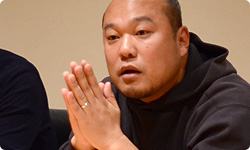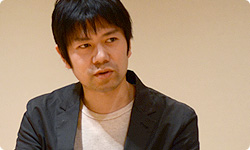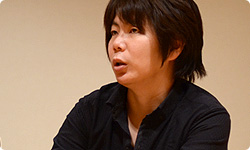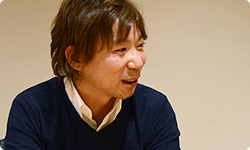5. Fear and Immersion
What was absolutely necessary in making this Resident Evil game?
We’ve always had fans play it at events, and the feedback from them was extremely helpful. That was huge.
But while fans’ comments are something to be extremely thankful for, they can be troubling and cause you to lose your way. Did you find that?
Yes, but like Hori-san mentioned earlier about haunted houses, that is precisely why we have the players try it out. During development, I read a book by Hirofumi Gomi14 who is a haunted house producer. And even in haunted houses, they make adjustments looking at the visitors’ reactions. That is exactly like making a Resident Evil game. We check the players’ reactions and say, “Let’s have the enemy appear half a second later,” and make repeated adjustments. 14Hirofumi Gomi: A haunted house producer in Japan.

So there is incredible value to watching how people actually react to it live.
Exactly. When you make horror games, you get desensitised and lose sight of what’s scary. We’ll make the games logically thinking, “This must be scary," but since it’s all just logic, live events are important for testing the results of that.
If the player is surprised, you can rest easy and feel satisfied.
Yes. But sometimes we think, “Huh? Is that part really that scary?” So we do in-house testing as well, and when I see someone playing with the palms of their hands all sweaty, I think, “You’re super scared!” (laughs) But fear, even as far as emotions go, is difficult. Resident Evil surprises you, somewhat like a haunted mansion, but even though they are seeing the same thing, there are people who get scared and people who don’t.
I do feel like there are bigger personal differences in fear than laughter. Some put on a brave face and pretend like they aren’t scared, while others show their fear openly. There are various patterns, so it’s a tricky matter.
Yes. Some people get really scared of psychological things, some are surprised by a direct surprise, while some enjoy something gory. In that way, compared to comedy, horror still has room for study.
When it comes to music, sometimes we use bright music in a dark scene, and that incongruity causes fear.

If there’s usually a balance but suddenly there’s an imbalance, our emotions grow unsettled. What is different about how the final product feels as horror on a handheld?
Laughter is shared by all, but horror is one-on-one, I believe. So the immersion of staring into a handheld’s small screen is great for horror.
And being able to see 3D without glasses is great, as well. You can concentrate without being distracted.
There’s a stronger feeling of exploring. For example, if you wonder what’s inside a cave, that feeling of diving in deeper and deeper is unique to the Nintendo 3DS system. In that way, it’s perfect for the limited setting of the inside of a ship.
At first, among the reasons we decided to focus on horror after E3 were the 3D immersion and the fact that it was a handheld. We thought that the game world would be right there and we would be able to make the players feel quite literally as if something was around the corner when they turn the corner in a the hallway. The reason we had the story unfold in a ship was to make use of its sense of its limited space.
However, nothing but the inside of a ship would get repetitous, so we introduced some variation, like snowy mountains and coasts.
Yes. We were imagining a serial drama, and you play handheld games for relatively short periods of time, so we wanted to make contrast by introducing more variation to the settings. I wanted players to think, “Ugh! Here again?!” when returning to the ship from out in the open.
That’s like a drama, too.
Yes. I think it came off well.
It’s structured like a drama, so the events aren’t always in chronological order. I think that’s a first for Resident Evil.

Oh, that’s right. The scriptwriters wanted to create suspenseful elements like in a foreign drama in order to introduce a feeling of unease to the players. Like, “Huh? What’s going on?” and the mystery pulls you into the story.
Also, I think a fully-fledged Resident Evil game that you can carry around is incredibly appealing.
Huh? But as a sound designer, wouldn’t you be happier if people played home in bed with headphones on?
Oh...right, well people can enjoy it both ways. (laughs)
(laughs)
To take a different approach, there are two screens, so when they touch the bottom screen, a lot of players will take their eyes away for a second. When you’re playing, that moment awakens a feeling of horror.
Oh, I see.
You’re extremely uneasy about looking away. An enemy might get you or something might jump out while your eyes are elsewhere. Those types of elements contribute to the feeling of horror.

It’s a structure that heightens the fear. Of course, holing up in your room is one way to play, but handhelds allow you to freely change the time, place and occasion, so I think the ways people play will change. What do you think about that?
For example, if the console goes to sleep, the game would pause. As a horror game we hesitated in allowing the player to pause the game at will, but we decided it would be necessary as a portable game. And the cliffhanger structure of the story allows you to confirm your progress so far. So I think it’s easier to get into compared to previous Resident Evil games.
We were firm about that for the main game, but since it’s for a handheld, you want to get together with someone and play, right? That gave birth to Raid Mode.